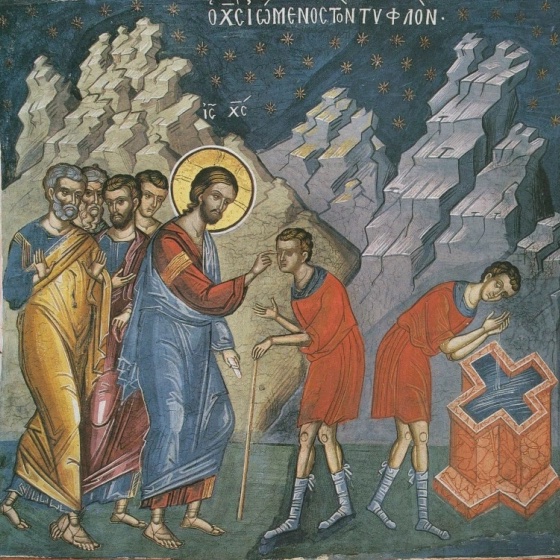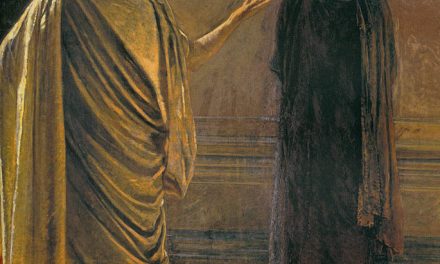The readings for this Sunday may be found on the USCCB website:
One of the most pernicious aspects of modernity’s triumphal account of the period of social, intellectual, and technological transformation that took place during the 16th-19th centuries is the name given to it: “the Enlightenment.” The acceptance of this appellation is now so widely accepted that many assume the word “enlightenment” refers primarily either to this historical period itself or to what its scholarly protagonists take to be its central leitmotif, the “freeing [of] human understanding from the accepted and customary beliefs sanctioned by traditional, esp. religious, authority, chiefly by rational and scientific inquiry” (definition 1b in the Oxford English Dictionary). It therefore comes as a surprise to many when they learn that for early Christians, the term “enlightenment” (photismos) referred primarily to baptism. Indeed, Orthodox and Byzantine Christians still refer to the baptismal rite as the liturgy of “holy enlightenment” or “holy illumination,” and speak of the one baptized as “newly enlightened” (neophotismos). Though this particular use of the term is less common among Roman Catholics, the Catechism of the Catholic Church still emphasizes its theological relation to baptism. Quoting Justin Martyr, it states that “this bath [baptism] is called enlightenment, because those who receive this [catechetical] instruction are enlightened in their understanding” (St. Justin, Apol. 1,61,12). Yet the relationship between baptism and “enlightenment” is about more than just intellectual comprehension. As the Catechism goes on: “having received in Baptism the Word, ‘the true light that enlightens every man,’ the person baptized has been ‘enlightened,’ he becomes a ‘son of light,’ indeed, he becomes ‘light’ himself (CCC 1216).”
Although these two senses of “enlightenment” are obviously very different, they share a common essential feature. They both point to a fundamental reliance on a particular authority as the means by which one can perceive and pursue truth. In the modern use of the term, scientific inquiry is this authority, while in the other it is sacramental participation in the Word (Logos) made flesh. In both cases, there is some ultimate authority that is the orienting touchstone by which one defines true knowledge and true freedom. In each case, “enlightenment” implies a definitive reference point in relation to which a whole view of the world emerges. “Enlightenment” therefore implies an all-embracing posture toward knowledge, freedom, and history based upon some final authoritative source of “light.” As such, both uses of the term refer to ways of “being in the world” made possible by absolute reliance on that which enables the possibility of identifying and pursuing truth. “Enlightenment” thus always makes reference to some “light” that is the necessary condition for the possibility of “seeing” anything at all.
In this Sunday’s Mass readings, we find a beautiful depiction of the Christian reality of “enlightenment.” They invite us to reflect on what it means to truly “see,” what makes it possible, and what difference it can make in our lives. The first two readings are about David, and they disclose an initial answer to the question of what it means to “see rightly.” The Lord sends Samuel to Jesse of Bethlehem to anoint a new king, already chosen from among Jesse’s sons. Samuel arrives with his horn of oil at the ready, and immediately assumes that the first son he sees must be the new chosen king. But the Lord intervenes, and so reveals the first step to true sight, namely the acknowledgment that “not as man sees does God see, because man sees the appearance but the Lord looks into the heart” (1 Sam 16:7). In order to see rightly, one must first admit one’s inability to see. On its own, our power of determining what stands before us is inadequate, for only God knows the whole truth about the world. Thus the first step to “enlightenment” is to rely upon the sight of another, who “looks into the heart” of things and sees them as they truly are.
Psalm 23 gives a brief sketch of David’s “heart,” his way of seeing and living in the world. The key to his survival and his flourishing lies outside himself, just as the well-being of his sheep lies entirely in his hands. The shepherd is able to lead, guide, refresh, protect, encourage, nourish, and sustain his sheep only because he knows more about them than they know about themselves; he sees them more truly than they see themselves. A sheep’s orientation to the world and to their whole mode of existence relies upon their relationship to their shepherd. The shepherd is their point of reference for “seeing” what is around them and how they should respond to it, for the shepherd sees what they need in a deeper and more far-reaching way than they ever could. David acknowledges his own similar reliance upon the Lord, who knows his heart more intimately than he himself ever will. It’s important to mention, however, that the heart the Lord saw in David on the day of his anointing is not only the contented heart of Psalm 23, but also the broken heart of Psalm 51, in which David laments his grievous sin with Bathsheba and begs for the Lord’s mercy. David’s heart expresses deep faith and trust in the Lord, but it also produces those “fruitless works of darkness” which St. Paul thinks are shameful even to mention: lust, envy, adultery, murder, lying. The Bible itself goes on to call David “a man of blood” (1 Chr 28:3). How can he then be “a man after God’s own heart?” The key word here is “after,” which suggests not so much a perfected ability as an enduring desire to “see as God sees.” Like his son Solomon, David has “a heart that sees” not only God’s goodness but also his own evil. David is able to “see” only because he readily admits to his own blindness. He pursues God’s own heart by allowing his own crooked heart to be broken again and again so that it might remain continually malleable in the Lord’s hands.
St. John’s gospel takes this initial point about “seeing” to an even deeper level in his story of the man born blind. For to one born blind, there is no question about the relationship between human and divine seeing. Sight itself would be something completely foreign, almost unintelligible, to one who has never experienced it. If you never saw anything ever in your life, what would it mean for you to hear others’ descriptions of sight? What would even the most eloquent description of “color” mean to you if you never saw anything of any color? And what would it mean to hear the words “not as man sees does God see” if you didn’t know from experience what it was like to see anything? In the man born blind, we encounter not merely the possibility that we do not see things rightly, as God does, but the more extreme possibility that we do not see at all, that we lack any reference point for knowing what “seeing” is or what it would involve.
In response to the disciples’ question of whose sin was responsible for the man’s blindness, Jesus responds:
“Neither he nor his parents sinned; it is so that the works of God might be made visible through him. We have to do the works of the one who sent me while it is day. Night is coming when no one can work. While I am in the world, I am the light of the world” (Jn 9:3-5)
Many interpreters, particularly those interested in the “problem of evil,” tend to focus almost exclusively on Jesus’ refusal to entertain the question of sin’s relationship to the man’s blindness. Jesus is not interested in the etiology of the man’s impairment, nor of the suffering it may have caused him. His interest is rather in making the works of God visible through him. And lest one think this explanation makes the man’s blindness a mere “prop” intended to highlight Jesus’ power to perform miracles, one should ask whether there is any human condition or circumstance that is not ultimately ordered to the manifestation of God’s works. The man’s blindness, like every other contingent fact about the universe, takes on its true meaning only in light of God’s own understanding of creation, and his ultimate intentions for it. It is as if Jesus is saying to his disciples “what you see when you look at this man is his blindness, and what you see in his blindness is sin. But that only demonstrates that you are the ones who are blind. You see nothing of the truth of what lies before you; you don’t even have a reference point for imagining what it would be like to see it.” That is why Jesus goes on to say that he must do God’s work while it is day, and that it is day only because he is at work in the world.
In this story, both the disciples and the Pharisees are blind. It’s not just that they are proud and refuse to admit that they “do not see as God sees.” In terms of understanding the truth about what they “see,” they are blind in the way the man born blind is: they have no way of even knowing what it would be like to see. They have no light. And so Jesus tells them that he is the light. To “see as God sees,” in this case as in any other, is to see the world as Jesus sees it. Only through the eyes of Jesus can we see the truth about the world, and about those we encounter in it. Yet “seeing as Jesus sees” is not so much about perfecting a capacity we already have to an imperfect degree; it is rather about participating in the light that makes all seeing possible. Jesus is not merely “the enlightened one” who knows the full truth about the world; he is the very principle of intelligibility (the logos) by which any and all truth is known. That is why for Christians, incorporation into Christ through baptism is about more than just the correction of a capacity for knowledge and goodness. In the Christian view of “enlightenment,” one not only receives light, but becomes light through participation in Christ himself. Christ gives us light so that we might become bearers of the light by which the truth and goodness of the world can be seen.



